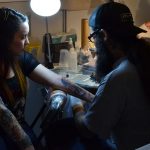Are All Body Modifications Legal in Australia?

From horn implants to split tongues and scrotal injections – extreme forms of body art, sometimes called ‘body modifications’, are becoming increasingly popular and gaining greater social acceptance.
But Australian law doesn’t seem to be keeping up with changing attitudes regarding such forms of self-expression.
Body Art and the Law
Standard tattoos and piercings are accepted forms of body art in Australia, and are regulated by public health laws and local council bylaws in all States and Territories.
In NSW, the Tattoo Parlours Act 2012 requires all tattooing businesses and their staff to be licensed. Tattooing without a licence carries a maximum penalty of 100 penalty units, or $11,000, as well as a criminal record.
Tattoo licensing systems focus heavily on the perceived character of those who apply for a licence, requiring criminal record checks and prohibited those who are suspected of being linked to alleged criminal organisations such as ‘bikie gangs’.
Body, nose and ear piercing as well as tattooing fall within the definition of ‘skin penetration procedures’ under the Public Health Act 2010 (NSW) and its corresponding regulations.
The laws impose standards of hygiene that all practitioners must abide by, but do not regulate more extreme forms of body art such as embedding objects into the skin, branding and splitting tissue.
Due to the omission, practitioners who perform these procedures can place themselves at risk of falling foul with the criminal law – as two men from New South Wales recently discovered.
Body Mods Charged
The men are currently facing charges of manslaughter and female genital mutilation in a matter that has been set down for trial in May 2020.
Brendan Russell is facing a charge of manslaughter for allegedly implanting a snowflake under a women’s skin with her consent in 2017, which subsequently became infected. The woman died of blood poisoning a few weeks later.
Mr Russell is also accused of using a branding iron to mutilate a female customer’s genitals in 2016, with the assistance of his co-accused Howard Rollins.
Mr Russell is also facing a third charge relating to a ‘tummy tuck’ on a woman who later had to seek medical attention, as a hole allegedly severed her stomach muscles.
The case is expected to set an important precedent relating to work of this kind.
What about consent?
It is important to be aware that consent is not a valid defence to certain criminal offences.
So while consent can overcome certain charges, including where a person is playing a contact sport and the subject injury was sustained in the course of the game, it may not help a person who is accused of inflicting serious harm, especially if their actions was outside accepted conduct.
For example, the infamous House of Lords case of R v Brown [1993] All ER 75 set a longstanding precedent – that has been cited with approval in Australian case law – that in cases of serious harm, consent will not suffice as a defence.
The facts of the case involved consensual sadomasochistic activities including genital torture, branding and bloodletting, and the House was called upon to decide whether consenting to these activities means they are legal.
In reaching his decision, Lord Templeton found that:
“Society is entitled and bound to protect itself against a cult of violence. Pleasure derived from the infliction of pain is an evil thing. Cruelty is uncivilised.”
The Court drew a line between harm that is caused in the course of accepted social conduct, such as playing football or boxing, and ‘uncivilised’ acts such as torture, which consent does not excuse.
And in the 2018 UK case of R v BM, the court found that similar rationale can be applied to body modification practitioners.
In R v BM, a body mod artist was charged with three counts of actual bodily harm for removing a customer’s ear, another customer’s nipple and splitting another’s tongue all without anaesthetic. All of the customers consented to the procedures.
Relying on the rationale of R v Brown, the England and Wales Court of Appeal found that consent to extreme body modifications does not act as a defence to criminal charges. In summing up, Justice Nawaz stated:
“…medical procedures performed for no medical reason and with none of the protections provided to patients by medical practitioners…the personal autonomy of the appellant’s customers did not justify removing body modification from the ambit of the law of assault.”
Legislation in New South Wales
Laws have been passed in our state which make it clear that certain acts can never be excused, regardless of whether or not consent is given.
For example, female genital mutilation is offence under section 45 of the Crimes Act 1900 which carries a maximum penalty of 21 years in prison.
To establish the offence, the prosecution must prove beyond reasonable doubt that the defendant:
- Excised, infibulated or otherwise mutilated the whole or any part of the labia majora, labia minora or clitoris of another person, or
- Aided, abetted, counselled or procured another person to do so.
It is not an offence to perform a surgical operation which causes female genital mutilation where it is done by:
- A medical practitioner and is necessary for the medical welfare of the other person,
- A medical practitioner or authorised professional on a person in labour or who just gave birth and is connected with that labour or birth, or
- A medical practitioner and is a sexual reassignment procedure.
A ‘medical practitioner’ is a person authorised under the law to practise medicine.
An ‘authorised professional’ includes:
- A registered midwife
- A midwifery student, and
- A medical student
A ‘sexual reassignment procedure’ is that which alters the genital appearance to that of the opposite sex.
So in summary, body modification practitioners would be well advised to steer away from inflicting what may amount to serious injuries under the law, as to do otherwise could render them liable for criminal prosecution in addition to civil remedies such as damages.







